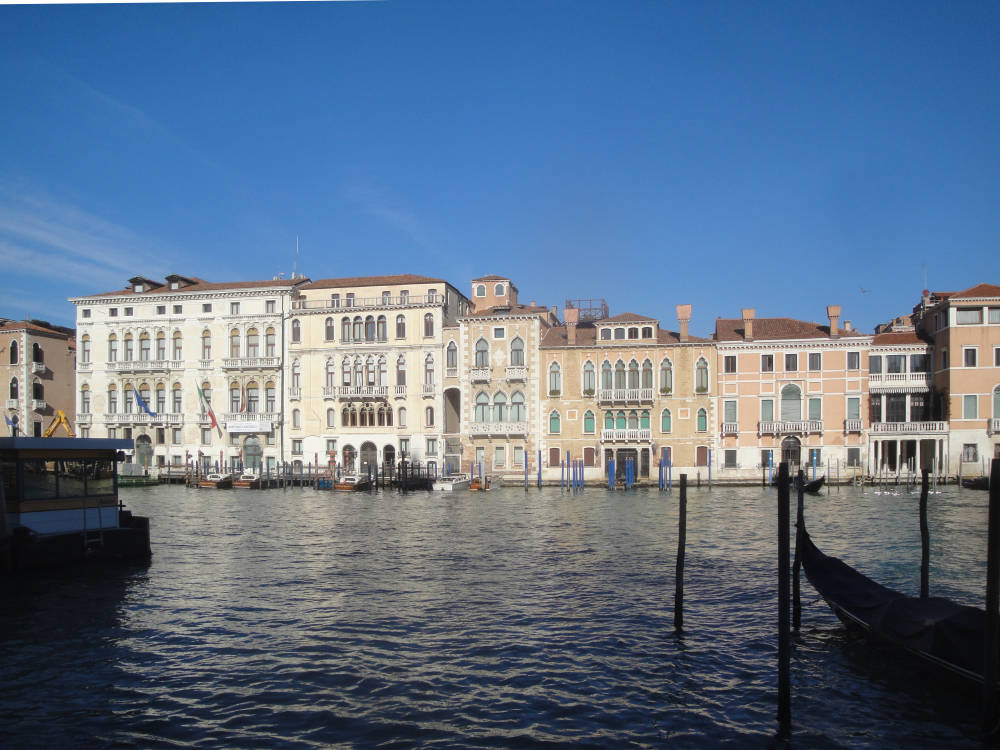

this little building on the Grand Canal and the buildings surrounding it. Click on images to enlarge them.

The Palazzo Contarini-Fasan, Venice. John Ruskin. 1841. Graphite, watercolor, and bodycolor, with some scratching out, on grey paper, 42.8 x 31.5 cm. The Ashmolean Museum (WA.RS.REF.065) Presented by John Ruskin to the Ruskin Drawing School, University of Oxford, 1875
In 1841 John Ruskin, who long admired this little building, drew it in the style of Samuel Prout, and he mentions it in both The Seven Lamps of Architecture (1848) and The Stones of Venice. For example, he describes and defends this little building in The Stones of Venice: “The richest work of the fifteenth century domestic Gothic in Venice, but notable more for richness than excellence of design. In one respect, however, it deserves to be regarded with attention, as showing how much beauty and dignity may be bestowed on a very small and unimportant dwelling-house by Gothic sculpture. Foolish criticisms upon it have appeared in English accounts of foreign buildings, objecting to it on the ground of its being ‘ill-proportioned;’ the simple fact being, that there was no room in this part of the canal for a wider house, and that its builder made its rooms as comfortable as he could, and its windows and balconies of a convenient size for those who were to see through them, and stand on them, and left the “proportions” outside to take care of themselves; which, indeed, they have very sufficiently done; for though the house thus honestly confesses its diminutiveness, it is nevertheless one of the principal ornaments of the very noblest reach of the Grand Canal, and would be nearly as great a loss, if it were destroyed, as the Church of La Salute itself” (11.368-69).
In his chapter on Gothic palazzi in the second volume of The Stones of Venice he discusses the carving on the building’s balconies, and earlier in “The Lamp of Memory” from The Seven Lamps of Architecture (1848) he mentioned it in passing while arguing that “to this day, the interest of the “fairest cities” of Italy and France “depends, not on the isolated richness of palaces, but on the cherished and exquisite decoration of even the smallest tenements of their proud periods. The most elaborate piece of architecture in Venice is a small house at the head of the Grand Canal, consisting of a ground floor with two storeys above, three windows in the first, and two in the second” (11.228; the editors of the Library Edition identify the building in a footnote).
More of Ruskin's Venice
- St. Mark’s
- The Palazzo Ducale, Venice
- The Scuola de San Rocco
- On the Grand Canal
- Leaving the Grand Canal
- On the way to Venice from the mainland
- Venice: Details and Corners
Photographs 2020. [You may use these images without prior permission for any scholarly or educational purpose as long as you (1) credit the photographer and (2) link your document to this URL in a web document or cite the Victorian Web in a print one.]
Bibliography
Ruskin, John. The Works. Ed. E. T. Cook and Alexander Wedderburn. “The Library Edition.” 39 vols. London: George Allen,1903-1912.
� �
Last mnodified 19 March 2020